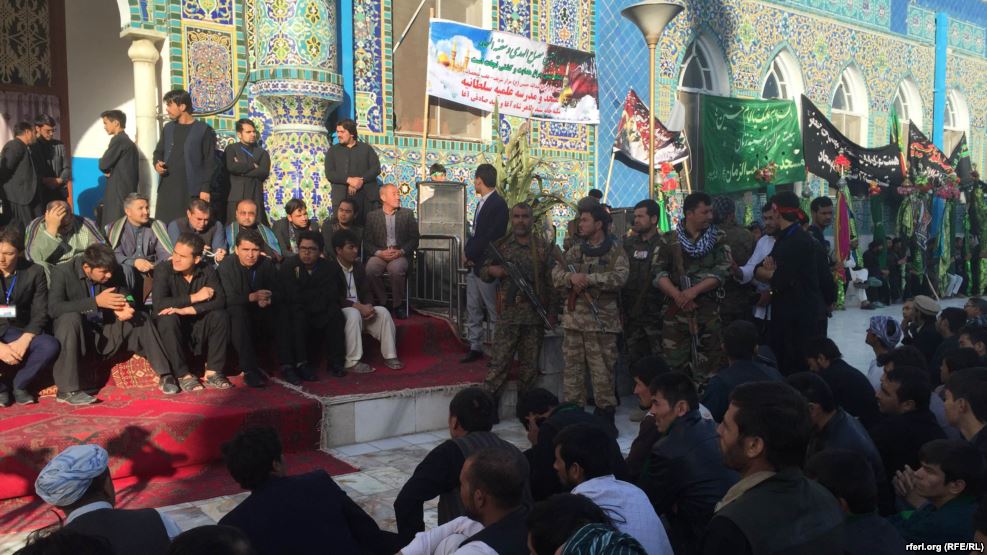14 Dead As Second Blast In 24 Hours Hits Shias In Afghanistan

NEW DELHI: At least 14 people were killed when a bomb went off outside a Shia mosque in Afghanistan on Wednesday. Another 24 people were wounded in the attack, that targeted the minority Shia community as devotees had congregated to mark Ashura at the mosque, which is located about 20 km from Mazar-i-Sharif, the capital of Afghanistan's northern Balkh province.
“The explosion happened at the gate of the Shia mosque in the centre of Balkh district (in Balkh province),” Munir Ahmad Farhad, the provincial governor’s spokesperson, said.
There was no immediate claim of responsibility. The attack comes less than 24 hours after at least 18 people were killed and another 50 wounded in an attack targeting Shias in the Afghan capital of Kabul. The Islamic State claimed responsibility for the attack. The attack targeted one of the cities largest shrines where devotees had gathered for Ashura, with an ensuing gunbattle resulting in the death of the attacker.
Attacks targeting Shias in Afghanistan, however, are becoming increasingly commonplace, with the most brutal attack on the community in recent years taking place in July this year, as 80 people were killed when a bomber targeted a protest march by members of the Hazara minority - a Shia minority group. The so-called Islamic State claimed the attack, marking a decisive shift in the nature of attacks in Afghanistan, as before the July attack, Afghanistan had not seen the same level of violence against Shia Muslims as neighbouring Pakistan.
The attacks represent a worsening security situation in Afghanistan, and even though claimed by the Islamic State, comes as the Taliban makes massive gains throughout the country -- especially in the provinces of Helmand and Kunduz. Reports from the ground state that Lashkar Gah is in lockdown with only a few shops open and many families trying to flee the fighting. Schools and universities across the province have been closed indefinitely. Reports from Kunduz tell the same story, with news routinely breaking that the Taliban have pushed into Kunduz city before being repelled by Afghan forces.
In fact, at the time of writing, officials in Afghanistan said that the Taliban pressed further into the capital of Helmand province on Wednesday, with fighting seeing rockets launched at the governor’s compound in Lashkar Gah. Over the past week, Afghan forces been fighting a multipronged offensive by the Islamist militant group on the outskirts of provincial capitals including Farah in the southwest, Pul-i-Khumri in the northeast and Tarin Kot in the south, which has for weeks been in danger of collapse.
Taliban fighters managed to capture the district of Ghormach in Afghanistan's northwestern Faryab province on Tuesday.
At least 96 Afghan soldiers have been killed in the past week in battles with the Taliban, according to the Afghan defence ministry.
Afghan and NATO forces repeatedly insist that neither Lashkar Gah or Kunduz are at risk of falling to the Taliban, but reports from the ground differ as the Taliban closes in on both cities and controls large swathes of the surrounding territory.
The result of the push in fighting is a spike in civilian casualties, with UN Assistance Mission in Afghanistan (UNAMA) documenting 1,601 civilian deaths and 3,565 injured civilians between January and June this year, an increase of four per cent in the total number of casualties compared to the first six months of 2015.
The total civilian casualty figure recorded by the UN since 1 January 2009 through 30 June 2016 has risen to 63,934, including 22,941 deaths and 40,993 injured.
“The testimony of victims and their families brings into agonizing focus the tragedy of each one of the 63,934 people killed or maimed by this protracted conflict since 2009,” said UN High Commissioner for Human Rights Zeid Ra'ad Al Hussein in a press release.
This year's casualties include 1,509 children, 388 dead and 1,121 injured, a figure Zeid described as “alarming and shameful,” particularly as it represents the highest numbers of children killed or wounded in a six-month period since counting began in 2009.
There were also 507 women casualties, 130 killed and 377 injured.
The figures are conservative – almost certainly underestimated – given the strict methodology employed in their documentation and in determining the civilian status of those affected.
In the press release, Tadamichi Yamamoto, the Secretary-General's Special Representative for Afghanistan and head of UNAMA, stressed that the report must serve as a call to action by parties to the conflict “to do all they can to spare civilians from the horrors of war.”
“Every single casualty documented in this report – people killed while praying, working, studying, fetching water, recovering in hospitals – […] represents a failure of commitment and should be a call to action for parties to the conflict to take meaningful, concrete steps to reduce civilians' suffering and increase protection,” Yamamoto said.
“Platitudes not backed by meaningful action ring hollow over time. History and the collective memory of the Afghan people will judge leaders of all parties to this conflict by their actual conduct,” he added.



